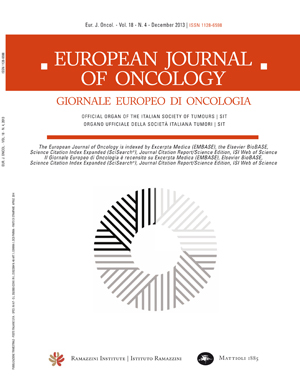A cross-sectional observational study to establish the association between ECOG performance status and age and administration of doublet or triplet chemotherapy containing Xeloda® (capecitabine) in advanced gastric cancer patients
Keywords:
ECOG, age, triplet or doublet chemotherapy regimen, capecitabineAbstract
Background: Selection of treatment for advanced gastric cancer (AGC) correlates with age and ECOG PS. This study was carried out to analyze whether previously mentioned variables are relevant for the choice of doublet or triplet regimens with capecitabine (Xeloda®) and determining prognosis. Methods: Multicenter, cross-sectional, observational study in patients with AGC who received at least 2 cycles of capecitabine-based doublet or triplet chemotherapy, with or without measurable disease. Results: A total of 175 patients were evaluated. Median age 65.5 (56-72) years, male: 68% ECOG 0/1/2: 32.7%/55.6%/11.1%; 33% underwent doublet and 67% triplet chemotherapy. Tumor histology: adenocarcinoma (27.4%), signet ring cell carcinoma (28%) and others (41.7%). Most common sites of metastases: lymph node (46.2%), peritoneum (39.4%) and liver (36.6%). Multivariate analysis demonstrated that age ≤64 (OR 0.447; p=0.016) and ECOG 0 (vs 2) (OR 0.253; p=0.016) were risk factors for the choice of triplet chemotherapy, and failed to show an association between ECOG 1 and regimen. With regard to the secondary endpoints, age was statistically related with treatment selection when considered numerical (p<0.01) or categorical (p<0.05) and ECOG PS also showed this relationship (p<0.01). Main grade 1/2 capecitabine-related toxicities: diarrhea (11.4%), mucositis (7%), hand-foot syndrome (4.6%) and emesis (4%). Most frequent grade 3 were diarrhea in 4.6% and emesis, asthenia and febrile neutropenia in 2.3%. No toxicity grade 4 occurred. Conclusions: Age ≤64 years and ECOG 0 are related factors of choice of capecitabine-based triplet chemotherapy in AGC.Downloads
Published
Issue
Section
License
OPEN ACCESS
All the articles of the European Journal of Oncology and Environmental Health are published with open access under the CC-BY Creative Commons attribution license (the current version is CC-BY, version 4.0 http://creativecommons.org/licenses/by/4.0/). This means that the author(s) retain copyright, but the content is free to download, distribute and adapt for commercial or non-commercial purposes, given appropriate attribution to the original article.
The articles in the previous edition of the Journal (European Journal of Oncology) are made available online with open access under the CC-BY Creative Commons attribution license (the current version is CC-BY, version 4.0 http://creativecommons.org/licenses/by/4.0/).
Upon submission, author(s) grant the Journal the license to publish their original unpublished work within one year, and the non exclusive right to display, store, copy and reuse the content. The CC-BY Creative Commons attribution license enables anyone to use the publication freely, given appropriate attribution to the author(s) and citing the Journal as the original publisher. The CC-BY Creative Commons attribution license does not apply to third-party materials that display a copyright notice to prohibit copying. Unless the third-party content is also subject to a CC-BY Creative Commons attribution license, or an equally permissive license, the author(s) must comply with any third-party copyright notices.

